

Complete Guide To Sweeteners on a Low-carb Ketogenic Diet. Most people on low-carb find that once they get used to the diet, the cravings for sugar go away.

Many even claim not to use any sweeteners at all. However, you may find it hard to give up sweets, especially at the beginning. I've been researching for natural low-carb sweeteners as well as other healthy alternatives to sugar. As always, there are many sweeteners you should avoid. I personally avoid using sweeteners regularly and only use them for occasional treats. Note: As all the other posts on my Blog, this post has not been sponsored. You can download a print-friendly version of this guide here! The Secrets of Sugar - the fifth estate. 10 Reasons Why Fructose Is Bad. It’s common knowledge in Paleo diet circles that sugar, especially the sugar fructose, should be limited and that it can cause a multitude of problems like those categorized under the metabolic syndrome umbrella term.
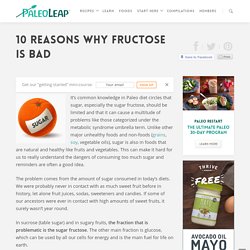
Unlike other major unhealthy foods and non-foods (grains, soy, vegetable oils), sugar is also in foods that are natural and healthy like fruits and vegetables. This can make it hard for us to really understand the dangers of consuming too much sugar and reminders are often a good idea. The problem comes from the amount of sugar consumed in today’s diets. We were probably never in contact with as much sweet fruit before in history, let alone fruit juices, sodas, sweeteners and candies.
If some of our ancestors were ever in contact with high amounts of sweet fruits, it surely wasn’t year round.
The Harmful Effects of Sugar - Wellness Mama. 10 Disturbing Reasons Why Sugar is Bad For You. Added sugar is the single worst ingredient in the modern diet.
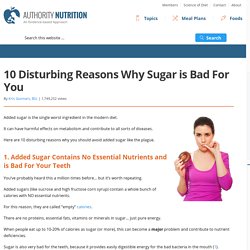
It can have harmful effects on metabolism and contribute to all sorts of diseases. Here are 10 disturbing reasons why you should avoid added sugar like the plague. 1. Added Sugar Contains No Essential Nutrients and is Bad For Your Teeth You’ve probably heard this a million times before… but it’s worth repeating. Added sugars (like sucrose and high fructose corn syrup) contain a whole bunch of calories with NO essential nutrients. For this reason, they are called “empty” calories. There are no proteins, essential fats, vitamins or minerals in sugar… just pure energy. When people eat up to 10-20% of calories as sugar (or more), this can become a major problem and contribute to nutrient deficiencies.
Sugar is also very bad for the teeth, because it provides easily digestible energy for the bad bacteria in the mouth (1). Advertisement Bottom Line: Sugar contains a lot of calories, with no essential nutrients. 2. 3. 4. 5. Lactose. Lactose is a disaccharide sugar derived from galactose and glucose that is found in milk.
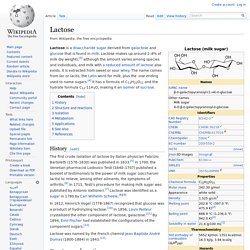
Lactose makes up around 2–8% of milk (by weight),[3] although the amount varies among species and individuals, and milk with a reduced amount of lactose also exists. It is extracted from sweet or sour whey. The name comes from lac or lactis, the Latin word for milk, plus the -ose ending used to name sugars.[4] It has a formula of C12H22O11 and the hydrate formula C12·11H2O, making it an isomer of sucrose.
History[edit] Galactose. Galactan is a polymer of the sugar galactose found in hemicellulose.
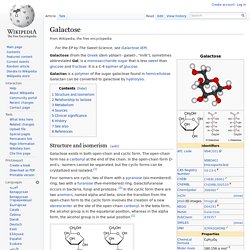
Galactan can be converted to galactose by hydrolysis. Structure and isomerism[edit] Galactose exists in both open-chain and cyclic form. The open-chain form has a carbonyl at the end of the chain. In the open-chain form D- and L- isomers cannot be separated, but the cyclic forms can be crystallized and isolated.[1] Fructose. Fructose, or fruit sugar, is a simple ketonic monosaccharide found in many plants, where it is often bonded to glucose to form the disaccharide sucrose.

It is one of the three dietary monosaccharides, along with glucose and galactose, that are absorbed directly into the bloodstream during digestion. Fructose was discovered by French chemist Augustin-Pierre Dubrunfaut in 1847.[4][5] The name "fructose" was coined in 1857 by the English chemist William Miller.[6] Pure, dry fructose is a very sweet, white, odorless, crystalline solid and is the most water-soluble of all the sugars.[7] Fructose is found in honey, tree and vine fruits, flowers, berries, and most root vegetables. Commercially, fructose is frequently derived from sugar cane, sugar beets, and corn. Crystalline fructose is the monosaccharide, dried, ground, and of high purity. High-fructose corn syrup (HFCS) is a mixture of glucose and fructose as monosaccharides. Chemical properties[edit] [edit] Glucose. This article is about the naturally occurring D-form of glucose.
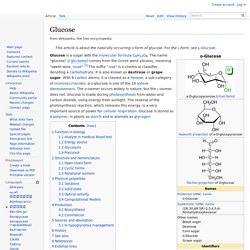
For the L-form, see L-Glucose. Glucose is a sugar with the molecular formula C6H12O6. The name "glucose" (/ˈɡluːkoʊs/) comes from the Greek word γλευκος, meaning "sweet wine, must".[3] The suffix "-ose" is a chemical classifier, denoting a carbohydrate. Cellulose. Cellulose is an organic compound with the formula (C 6H 10O 5) n, a polysaccharide consisting of a linear chain of several hundred to many thousands of β(1→4) linked D-glucose units.[3][4] Cellulose is an important structural component of the primary cell wall of green plants, many forms of algae and the oomycetes.

Some species of bacteria secrete it to form biofilms.[5] Cellulose is the most abundant organic polymer on Earth.[6] The cellulose content of cotton fiber is 90%, that of wood is 40–50% and that of dried hemp is approximately 45%.[7][8][9] Cellulose is mainly used to produce paperboard and paper. Smaller quantities are converted into a wide variety of derivative products such as cellophane and rayon. Conversion of cellulose from energy crops into biofuels such as cellulosic ethanol is under investigation as an alternative fuel source.
Sugar.